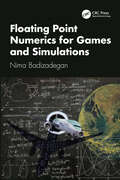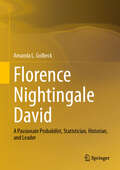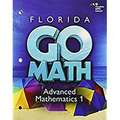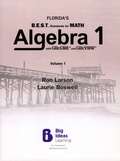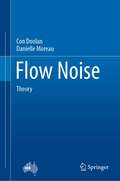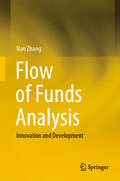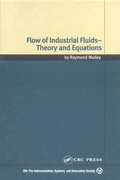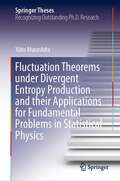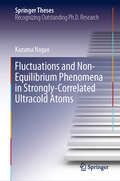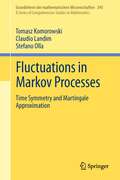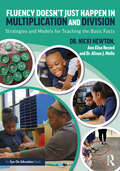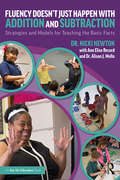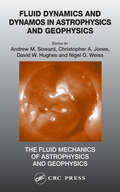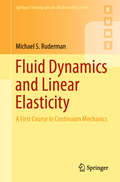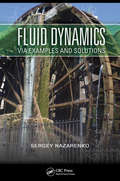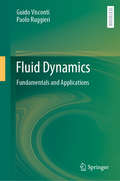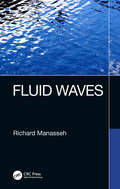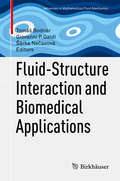- Table View
- List View
Floating Point Numerics for Games and Simulations
by Nima BadizadeganFloating point is ubiquitous in computers, where it is the default way to represent non-integer numbers. However, few people understand it. We all see weird behavior sometimes, and many programmers treat it as a mystical and imprecise system of math that just works until it sometimes doesn’t. We hear that we shouldn’t trust floating point with money, we know that 0.1 + 0.2 does not equal 0.3, and “NaN” shows up in our logs when things break. We rarely hear why any of this is the case, and less about what to do about it.This book pulls back the veil on floating point and shows how this number system we program with every day works. It discusses how to leverage the number system for common calculations, particularly in graphics and simulations, and avoid pitfalls. Further, we will review methods that can give you either better performance or better accuracy on tasks like numerical integration and function approximation, so you can learn to make the right tradeoffs in your programs.This book builds upon a basic knowledge of calculus and linear algebra, working with illustrative examples that demonstrate concepts rather than relying on theoretical proofs. Along the way, we will learn why Minecraft has struggled with boat physics and what the heck John Carmack was thinking with Quake III’s infamous fast reciprocal square root algorithm. By the end of the book, you will be able to understand how to work with floating point in a practical sense, from tracking down and preventing error in small calculations to choosing numerical building blocks for complex 3D simulations. Gives insight into how and why floating-point math works Describes how floating-point error arises and how to avoid it Surveys numerical methods important to graphics and numerical simulations Includes modern techniques to apply to your numerical problems Shows how to hack the floating-point numbers to compute faster and more accurately
Florence Nightingale David: A Passionate Probabilist, Statistician, Historian, and Leader
by Amanda L. GolbeckThis book examines Florence Nightingale David's life, contributions, and relationships throughout her life, as well as her subsequent legacy. Florence Nightingale David (1909-1993) was the first woman professor in the world's first academic statistics department, served in various British ministries during the war from 1939-1945, and was one of the first women to chair a statistics department in a research university. In this biography, the life stories of David are used as a vehicle to explore a variety of questions surrounding culture and engagement in the statistical sciences. What does it take to succeed in an environment that is not inclusive of your demographic? How can stories be used to bring technical material to life for students and other learners? And how can a nontraditional leader succeed in challenging boundaries and moving an enterprise forward?
Florida Benchmarks Practice Book for Home or School, Grade 1
by Houghton Mifflin HarcourtMath Activity Book-Grade 1: Florida Edition
Florida Benchmarks Practice Book for Home or School, Grade 2
by Houghton Mifflin HarcourtA math workbook in English and Spanish
Florida Go Math Advanced Mathematics 1
by Timothy D. Kanold Edward B. Burger Juli K. Dixon Matthew R. LarsonA mathematics textbook for middle school
Florida Go Math! Pre-Algebra
by Timothy D. Kanold Edward B. Burger Juli K. Dixon Steven J. Matthew R. Larson Martha E. Sandoval-Martinez LeinwandMiddle School Math Workbook
Florida Go Math: Mathematics 2
by Timothy D. Kanold Edward B. Burger Juli K. Dixon Steven J. Leinwand Matthew R. Larson Martha E. Sandoval-MartinezStandards for Mathematical Practice. The topics described in the Standards for Mathematical Content will vary from year to year. However, the way in which you learn, study, and think about mathematics will not. The Standards for Mathematical Practice describe skills that you will use in all of your math courses. These pages show some features of your book that will help you gain these skills and use them to master this year's topics.
Florida's B.E.S.T. Standards for Math-Algebra 1 w/CalcChat & CalcView Vol 1
by Ron Larson Laurie BoswellThis algebra workbook is an essential resource for intermediate students who want to excel in mathematics. It contains a wealth of information, including lessons, practice problems, and exercises that cover a variety of algebraic concepts. The publication, B.E.S.T. Standards for Math Algebra 1 with CalcChat & CalcView, is authored by Ron Larson and Laurie Boswell and published by Big Ideas Learning. This paperback workbook has a unit format and is part of the FL series. It was published in 2023 in the United States and is written in English. It features CalcChat, which is an online platform that allows students to receive instant feedback on their work. The book is suitable for personal use and is not personalized.
Flow Noise: Theory
by Danielle Moreau Con DoolanThis book highlights the importance of sound produced by fluid flow or flow-induced noise. Noise created by unsteady flow creates high levels of environmental noise pollution, a known public health problem, and can compromise the acoustic qualities of marine vessels. There is a seemingly ever-growing list of modern technology that created flow-induced noise which includes aircraft, wind turbines, submarines, drones, high-speed rail, and cooling fans. More scientists and engineers are required to incorporate the effects of flow-induced noise in their work. This book also provides a comprehensive introduction to the theory underpinning the understanding of flow-induced noise.
Flow of Funds Analysis: Innovation and Development
by Nan ZhangThis book discusses the theory, methods, and applications of flow of funds analysis. The book integrates the basic principles of economic statistics, financial accounts, international finance, econometric models, and financial network analysis, providing a systematic and comprehensive introduction to the interconnection between these research fields. It thus provides the reader with the intellectual groundwork indispensable for understanding the workings and interactions of today’s globalized financial markets. The main focus of the book is how to observe the flow of funds in macroeconomics, how to measure the global flow of funds (GFF), and how to use GFF data to carry out an analysis. Based on the statistical framework for measuring GFF under the System of National Accounts, the book identifies the systematic relationship of financial linkages among economic sectors and with the rest of the world while integrating data sources that include stock data, geographically broken down by country–region, and selected financial instruments. It sets out the GFF concept and constructs a GFF matrix (metadata) on a from-whom-to-whom basis within a country-by-country pattern. Lastly, an established GFF matrix table is used to conduct an empirical study including an econometric model and financial network analysis.
Flow of Industrial Fluids: Theory and Equations
by Raymond MulleyWith a novel approach that bridges theory and practice, this book uses a uniquely structured series of chapters and appendices to present the basic theory and equations of fluid flow with just the right amount of detail and discussion. Full derivations and explanations are relegated to chapter-specific appendices, making both aspects easier to access. The treatment is also organized to allow the more complex compressible flow theory and associated equations to build on the less complex. Anyone who must deal with industrial flow processes, equipment, or piping systems will find that this book effectively links theory to practice and builds the kind of insight they need to solve real-world problems.
Fluctuation Theorems under Divergent Entropy Production and their Applications for Fundamental Problems in Statistical Physics (Springer Theses)
by Yûto MurashitaThis book presents the derivation of the fluctuation theorems with divergent entropy production and their application to fundamental problems in statistical physics. It explores the two basic aspects of the fluctuation theorems: i) Applicability in extreme situations with divergent entropy production, concluding that the fluctuation theorems remain valid under the notion of absolute irreversibility, and ii) utility in the investigation of classical enigmas in the framework of statistical physics, i.e., Gibbs and Loschmidt paradoxes. The book offers readers an overview of the research in fundamental statistical physics. Firstly it briefly but skillfully reviews the modern development of fluctuation theorems to found the key theme of the book. Secondly it concisely discusses historical issues of statistical physics in chronological order, along with the key literature in the field. They help readers easily follow the key developments in the fundamental research of statistical physics.
Fluctuations and Non-Equilibrium Phenomena in Strongly-Correlated Ultracold Atoms (Springer Theses)
by Kazuma NagaoThis book discusses non-equilibrium quantum many-body dynamics, recently explored in an analog quantum simulator of strongly correlated ultracold atoms. The first part presents a field-theoretical analysis of the experimental observability of the Higgs amplitude mode that emerges as a relativistic collective excitation near a quantum phase transition of superfluid Bose gases in an optical lattice potential. The author presents the dynamical susceptibilities to external driving of the microscopic parameters, taking into account a leading-order perturbative correction from quantum and thermal fluctuations and shows clear signatures of the Higgs mode in these observables. This is the first result that strongly supports the stability of the Higgs mode in three-dimensional optical lattices even in the presence of a spatially inhomogeneous confinement potential and paves the way for desktop observations of the Higgs mode. In the second part, the author applies the semi-classical truncated-Wigner approximation (TWA) to far-from-equilibrium quantum dynamics. Specifically, he considers the recent experiments on quantum-quench dynamics in a Bose-Hubbard quantum simulator. A direct comparison shows remarkable agreement between the numerical results from TWA and the experimental data. This result clearly indicates the potential of such a semi-classical approach in reliably simulating many-body systems using classical computers. The book also includes several chapters providing comprehensive reviews of the recent studies on cold-atomic quantum simulation and various theoretical methods, including the Schwinger-boson approach in strongly correlated systems and the phase-space semi-classical method for far-from-equilibrium quantum dynamics. These chapters are highly recommended to students and young researchers who are interested in semi-classical approaches in non-equilibrium quantum dynamics.
Fluctuations in Markov Processes
by Claudio Landim Stefano Olla Tomasz KomorowskiThe present volume contains the most advanced theories on the martingale approach to central limit theorems. Using the time symmetry properties of the Markov processes, the book develops the techniques that allow us to deal with infinite dimensional models that appear in statistical mechanics and engineering (interacting particle systems, homogenization in random environments, and diffusion in turbulent flows, to mention just a few applications). The first part contains a detailed exposition of the method, and can be used as a text for graduate courses. The second concerns application to exclusion processes, in which the duality methods are fully exploited. The third part is about the homogenization of diffusions in random fields, including passive tracers in turbulent flows (including the superdiffusive behavior). There are no other books in the mathematical literature that deal with this kind of approach to the problem of the central limit theorem. Hence, this volume meets the demand for a monograph on this powerful approach, now widely used in many areas of probability and mathematical physics. The book also covers the connections with and application to hydrodynamic limits and homogenization theory, so besides probability researchers it will also be of interest also to mathematical physicists and analysts.
Fluency Doesn't Just Happen in Multiplication and Division: Strategies and Models for Teaching the Basic Facts
by Nicki Newton Ann Elise Record Alison J. MelloFluency in math doesn’t just happen; it is a well-planned journey. In this book, you’ll find practical strategies and activities for teaching your elementary students basic multiplication and division.The authors lay out the basic framework for building math fluency using a cycle of engagement (concrete, pictorial, abstract) and provide a multitude of examples illustrating the strategies in action. You’ll learn how to help students to model their thinking with a variety of tools; keep students engaged through games, poems, songs, and technology; assess student development to facilitate active and continuous learning; implement distributed practices throughout the year; and boost parental involvement so that students remain encouraged even as material becomes more complex.A final chapter devoted to action plans will help you put these strategies into practice in your classroom right away. Most importantly, you’ll open the door to deep and lasting math fluency.
Fluency Doesn't Just Happen with Addition and Subtraction: Strategies and Models for Teaching the Basic Facts
by Nicki Newton Ann Elise Record Alison J. MelloFluency in math doesn’t just happen! It is a well-planned journey. In this book, you’ll find practical strategies and activities for teaching your elementary students basic addition and subtraction facts. The authors lay out the basic framework for building math fluency using a cycle of engagement (concrete, pictorial, abstract) and provide a multitude of examples illustrating the strategies in action. You’ll learn how to: help students to model their thinking with a variety of tools; keep students engaged through games, poems, songs, and technology; assess student development to facilitate active and continuous learning; implement distributed practices throughout the year; boost parental involvement so that students remain encouraged even as material becomes more complex. A final chapter devoted to action plans will help you put these strategies into practice in your classroom right away. Most importantly, you’ll open the door to deep and lasting math fluency.
Fluid Dynamics and Dynamos in Astrophysics and Geophysics (The Fluid Mechanics of Astrophysics and Geophysics)
by Christopher A. Jones David W. Hughes Andrew M. Soward Nigel O. WeissThe increasing power of computer resources along with great improvements in observational data in recent years have led to some remarkable and rapid advances in astrophysical fluid dynamics. The subject spans three distinct but overlapping communities whose interests focus on (1) accretion discs and high-energy astrophysics; (2) solar, stellar, and
Fluid Dynamics and Linear Elasticity: A First Course in Continuum Mechanics (Springer Undergraduate Mathematics Series)
by Michael S. RudermanThis book provides a concise introduction to continuum mechanics, with a particular emphasis on fluid dynamics, suitable for upper undergraduate students in applied mathematics and related subjects.Starting with a preliminary chapter on tensors, the main topic of the book begins in earnest with the chapters on continuum kinematics and dynamics. Following chapters cover linear elasticity and both incompressible and compressible fluids. Special topics of note include nonlinear acoustics and the theory of motion of viscous thermal conducting compressible fluids.Based on an undergraduate course taught for over a decade, this textbook assumes only familiarity with multivariate calculus and linear algebra. It includes many exercises with solutions and can serve as textbook for lecture courses at the undergraduate and masters level.
Fluid Dynamics via Examples and Solutions
by Sergey NazarenkoFluid Dynamics via Examples and Solutions provides a substantial set of example problems and detailed model solutions covering various phenomena and effects in fluids. The book is ideal as a supplement or exam review for undergraduate and graduate courses in fluid dynamics, continuum mechanics, turbulence, ocean and atmospheric sciences, and relate
Fluid Dynamics: Fundamentals and Applications
by Guido Visconti Paolo RuggieriThis introductory book addresses a broad range of classical Fluid Dynamics topics, interesting applications, and related problems in everyday life. The geophysical and astrophysical applications discussed concern e.g. the shape and internal structure of the Earth and stars, the dynamics of the atmosphere and ocean, hydrodynamic instabilities, and the different kinds of waves that can be found in the atmosphere, ocean and solid Earth. Non-linear waves (solitons) are also mentioned. In turn, the book explores problems from everyday life, including the motion of golf balls, life at low Reynolds numbers, the physics of sailing, and the aerodynamics of airplanes and Grand Prix cars. No book on this topic would be complete without a look at chaos and turbulence; here the problems span from Gaussian plumes to chaotic dynamos, to stochastic climate modeling. Advances in fluid dynamics have produced a wealth of numerical methods and techniques, which are used in many of the applications. Given its structure, the book can be used both for an introductory course to fluid dynamics and as preparation for more advanced problems typical of graduate-level courses.
Fluid Waves
by Richard ManassehThe book derives the mathematical basis for the most encountered waves in science and engineering. It gives the basis to undertake calculations required for important occupations such as maritime engineering, climate science, urban noise control, and medical diagnostics. The book initiates with fluid dynamics basis with subsequent chapters covering surface gravity waves, sound waves, internal gravity waves and waves in rotating fluids, and details basic phenomena such as refraction. Thereafter, specialized application chapters include description of specific contemporary problems. All concepts are supported by narrative examples, illustrations, and case studies. Features:- Explains the basis of wave mechanics in fluid systems. Provides tools for the analysis of water waves, sound waves, internal gravity, and rotating fluid waves through different examples. Includes comprehensible mathematical derivations at the expense of fewer theoretical topics. Reviews cases describable by linear theory and cases requiring nonlinear and wave-interaction theories. Supports concepts with narrative examples, illustrations, and case studies. This book aims at Senior Undergraduates/Graduate students and Researchers in Fluid Mechanics, Applied Mathematics, Mechanical Engineering, Civil Engineering, and Physical Oceanography.
Fluid-Structure Interaction and Biomedical Applications
by Giovanni P. Galdi Tomáš Bodnár Šárka NečasováThis book presents, in a methodical way, updated and comprehensive descriptions and analyses of some of the most relevant problems in the context of fluid-structure interaction (FSI). Generally speaking, FSI is among the most popular and intriguing problems in applied sciences and includes industrial as well as biological applications. Various fundamental aspects of FSI are addressed from different perspectives, with a focus on biomedical applications. More specifically, the book presents a mathematical analysis of basic questions like the well-posedness of the relevant initial and boundary value problems, as well as the modeling and the numerical simulation of a number of fundamental phenomena related to human biology. These latter research topics include blood flow in arteries and veins, blood coagulation and speech modeling. We believe that the variety of the topics discussed, along with the different approaches used to address and solve the corresponding problems, will help readers to develop a more holistic view of the latest findings on the subject, and of the relevant open questions. For the same reason we expect the book to become a trusted companion for researchers from diverse disciplines, such as mathematics, physics, mathematical biology, bioengineering and medicine.
